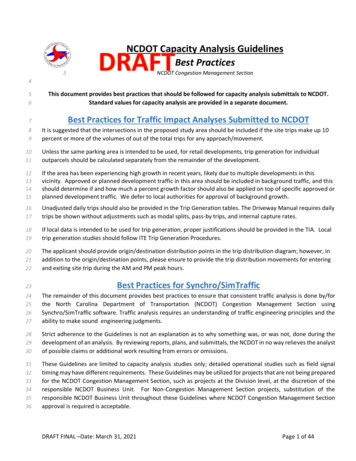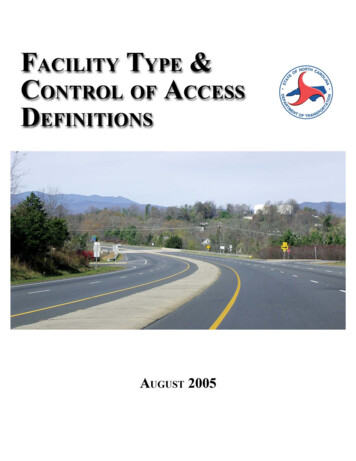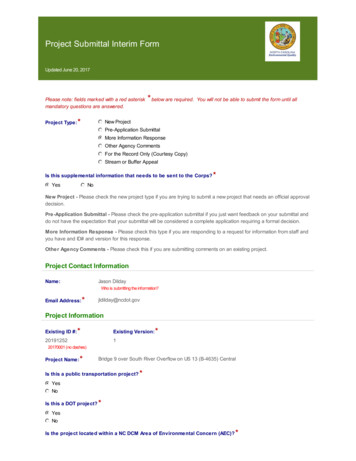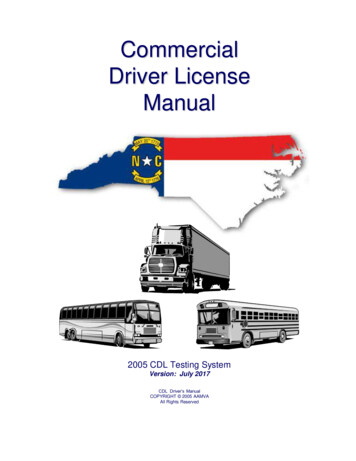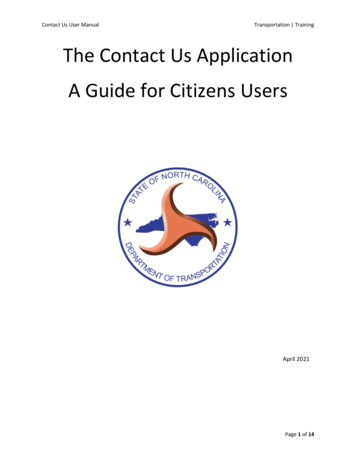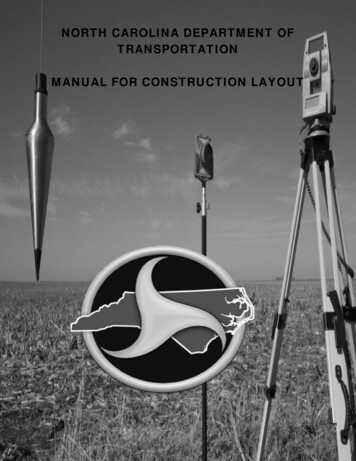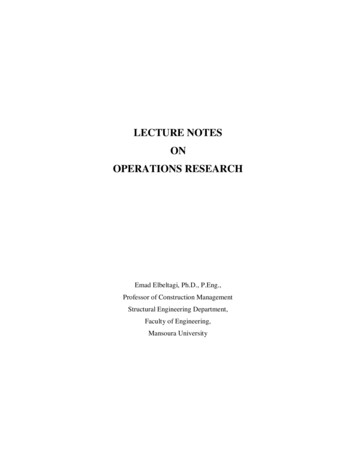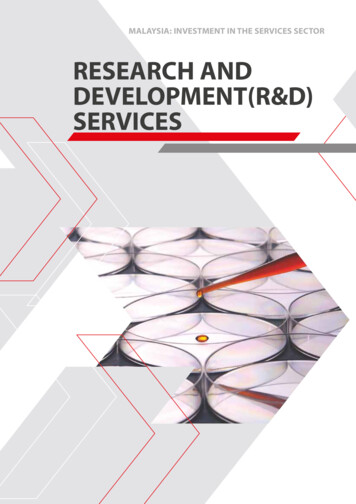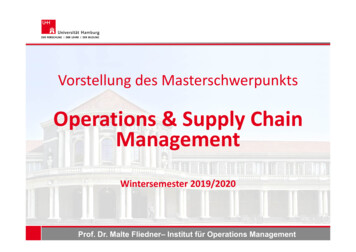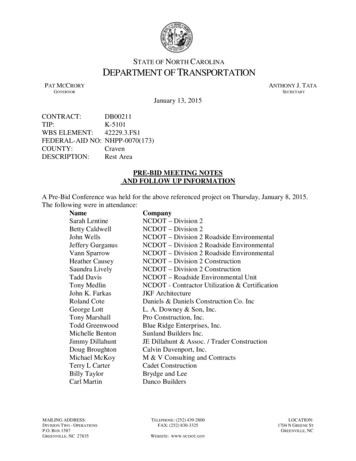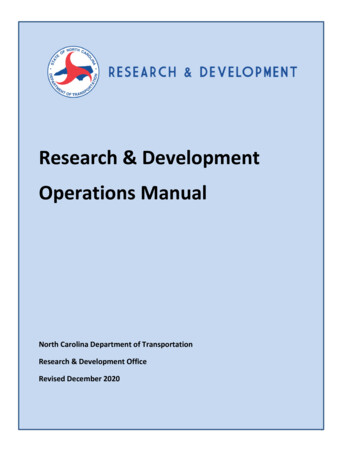
Transcription
NCDOT RESEARCH & DEVELOPMENT OPERATIONS MANUAL 2020Research & DevelopmentOperations ManualNorth Carolina Department of TransportationResearch & Development OfficeRevised December 2020i
NCDOT RESEARCH & DEVELOPMENT OPERATIONS MANUAL 2020TABLE OF CONTENTS1.0 Introduction .11.1 Document Purpose11.2 Basic Structure12.0 Background Research Program Information . 32.1 Federal Funding History32.3 Benefits of the Research Program32.4 Alignment with Departmental Vision, Mission, Goals and Values42.5 Authority52.6 Administrative Terms and Definitions53.0 Organization of the Research Program . 133.1 Research & Development Unit133.2 The North Carolina Department of Transportation Library133.3 Research Committees and Subcommittees144.0 Research Engagement, Partners, Customers & Transportation Research Centers . 204.1 Customer Support204.2 Research Partners204.3 Participation in Departmental Functions and Support of Research Centers214.4 Rapid Technical Assistance Program214.5 NCDOT Research & Development Innovation Summit215.0 Research Program Development. 225.1 Annual Work Program Cycle225.2 Research Solicitation Process235.3 Research Proposals255.4 Project Selection275.5 Project Authorization Contract Documents275.6 Work Program Submittal for FHWA Approval285.7 Proposals for National External Consideration295.8 Internal and Demonstration Research295.9 National Pooled Fund Participation296.0 Program Management and Reporting . 30ii
NCDOT RESEARCH & DEVELOPMENT OPERATIONS MANUAL 20206.1 Project Kick-Off Meetings306.2 Project Progress Meetings306.3 Quarterly Progress Reports306.4 Project Close-Out Meetings316.5 Project Final Reports316.6 Retention Requirements for Records336.7 Annual Reporting to FHWA337.0 Fiscal Procedures. 347.1 Review of Fiscal Documents347.2 Non-Expendable Research Equipment Procedures367.3 Funding External Obligations: Pooled Fund, TRB, NCHRP, AASHTO TSP, and Others378.0 National Report Distribution . 408.1 Reporting to TRID Database – Research In Progress (RIP)408.2 Transportation Library Distribution419.0 Research Peer Exchange Process . 429.1 Peer Exchange Participants429.2 Peer Exchange Report429.3 Meeting Frequency and Location429.4 Analysis of Peer Exchange4210.0 Implementation & Technology Transfer . 4410.1 R&D List of customers4410.2 R&D Outreach Activities4410.3 Implementation Champion and Responsible Unit4510.4 Implementation Status Reports and Actions4510.5 Technology Transfer Benchmarking4610.6 Technology Transfer4710.7 Implementation Follow-up and Surveys4711.0 Procedures for Intellectual Property . 4911.1 Computer Software and Data4911.2 Other Intellectual Property Provisions4911.3 Identification of Intellectual Property50iii
NCDOT RESEARCH & DEVELOPMENT OPERATIONS MANUAL 202011.4 Intellectual Property Disposition50LIST OF APPENDICES . 52iv
NCDOT RESEARCH & DEVELOPMENT OPERATIONS MANUAL 2020LIST OF APPENDICESAPPENDIX AR&D Office Organizational ChartAPPENDIX BResearch Committee GuidelinesAPPENDIX CTechnical Assistance Request FormAPPENDIX DResearch Proposal GuidelinesAPPENDIX EResearch Proposal EvaluationAPPENDIX FProject Authorization Cover PageAPPENDIX GTitle VI Notice of Non-DiscriminationAPPENDIX HQuarterly Progress ReportAPPENDIX IFinal Quarterly Progress ReportAPPENDIX JTechnical Report DocumentationAPPENDIX KImplementation Status ReportsAPPENDIX LTechnology Transfer Formv
NCDOT RESEARCH & DEVELOPMENT OPERATIONS MANUAL 20201.0 IntroductionTransportation Research is vital to the North Carolina Department of Transportation’s (NCDOT and/or theDepartment) on-going effort to improve transportation engineering, technologies and operations. It providesa means to develop solutions to improve mobility; build better, safer and longer-lasting highway, airport,transit and freight facilities; lessen the Department’s environmental impacts; provide safer conditions fordrivers and pedestrians and increase the service life of bridges and pavements.Improvements to our transportation networks are crucial to the success of the economy, educational system,recreational endeavors, environmental initiatives, and general quality of life. Effectively managedtransportation research programs are a valuable national and local resource. Long-term outcomes from theNCDOT Research and Development (R&D) program include savings to operations (reduced manpower needs,improved assets, lower bids, etc.), benefits to the public (reduced congestion, improved safety, enhancedenvironment, etc.) and increased knowledge (storm water strategies, material properties, etc.). A robustresearch program assists the Department, our customers and business partners in understanding andmaximizing the economic benefit of the overall Transportation Program.NCDOT seeks to conduct practical, implementable research that will serve the agency and the public at largefor many years.1.1 Document PurposeThis document describes the functions of the NCDOT’s Research and Development Office and presents amanagement process designed to incorporate department needs and goals into a cohesive program. Itincludes discussion of program development, project administration and management, training,implementation, external program support and federal funding requirements.This Research & Development Manual fulfills the U.S. Department of Transportation requirements to assurethe applicability of NCDOT’s research in meeting national research goals as referenced in 23 CFR Part420.209(7)(b).1.2 Basic StructureNCDOT develops and manages its research program using a three-tiered structure: At the top is the ResearchExecutive Committee (REC) composed of NCDOT Executives. Providing recommendations and input to the RECare five topical Research Technical Subcommittees. Each research project is assigned a Steering &Implementation Committee (StIC) that provides technical feedback to the researcher as well as Departmentalpersonnel. Internal customers and NCDOT Management play a primary role in setting the strategic directionfor research via the solicitation of research idea submittals, project approval, and implementation of results.To investigate defined research needs, the Department contracts with various universities, TransportationResearch Centers and consultants throughout the state and nation. The primary focus is on conductingresearch with North Carolina-based university programs, but specialized expertise may be needed from out-ofstate universities. As research projects involve graduate students, an additional benefit to solving real-worldproblems is the development and recruitment of the next generation of transportation professionals that willwork with NCDOT and its partners in the private sector and academia.1
NCDOT RESEARCH & DEVELOPMENT OPERATIONS MANUAL 2020In addition to contract research, this manual discusses the R&D Office’s role in providing support andcoordination for national level research activities through TRB, AASHTO, NCHRP, SHRP and Pooled Funds. TheR&D Office also provides contract review and project management services to NCDOT business unitsconducting research with universities using alternative funding sources.2
NCDOT RESEARCH & DEVELOPMENT OPERATIONS MANUAL 20202.0 Background Research Program Information2.1 Federal Funding HistoryFunding for transportation research began with The Federal Highway Act of 1921 which authorized the firstsustained fiscal support for highway research. Support for highway research was reaffirmed in the Federal-AidHighway Act of 1962 which mandated funds for planning and research purposes only. Transportation researchfunding was expanded with the Intermodal Surface Transportation Efficiency Act of 1991 (Public Law 102-240;ISTEA, pronounced Ice-Tea). As a result, the NCDOT broadened its approach to highway research anddevelopment. ISTEA included a provision assigning 2% of each state’s federal allocation to State Planning andResearch (Subpart B) funds. Within this Subpart B program, 25% of the funds were designated for researchactivities. ISTEA expired in 1997 and was followed by the Transportation Equity Act for the 21st Century (TEA21) in 1998 and the Safe, Accountable, Flexible, Efficient Transportation Equity Act: A Legacy for Users(SAFETEA-LU) in 2005. Further federal funding was authorized in 2012 with the Moving Ahead for Progress inthe 21st Century Act, followed by the Fixing America's Transportation Act in 2015. Beginning in 2021, thecurrent US House bill America's Transportation Infrastructure Act may provide another five years of programauthorization.Involvement with highway research began in the North Carolina Department of Transportation (formerly theNorth Carolina State Highway Commission) in January 1959 with the establishment of cooperatively fundedstudies at North Carolina State University. The first permanent research staff member in the former StateHighway Commission, a Highway Research Coordinator, was employed in 1967 and this official was assigned toa newly created Planning & Research Branch. Under the provisions of annually renewable cooperativeagreements and the oversight of a Research Steering Committee, the Planning & Research Branch continued tocontract with the North Carolina State University Engineering Research Services Division through 1981.In 1981, a research and development agreement was executed with the Institute for Transportation Researchand Education (ITRE) which provided the Department an avenue to undertake contractual research with statesupported universities in North Carolina. This agreement with ITRE was superseded by a Master Agreementfor Services for Research and Development and Training Projects in 1988.The R&D Office was formed in 1990 and assigned to the Statewide Planning Branch and later the ProgramDevelopment Branch. In 2009, the R&D Office was reassigned to the Technical Services Division and shortlythereafter established Master Agreements with individual universities. Over the past few years, the R&DOffice was designated to Transportation Programs Management under the Technical Services Division.Currently, the R&D Office has been assigned to the Field Support Unit under the Division of Highways.2.3 Benefits of the Research ProgramThis document provides a framework for the administration of NCDOT's Research & Development Programand sets forth procedures that comply with the state planning and research program administration issued bythe Federal Highway Administration (FHWA.)The programs, projects and products generated by the R&D Office, provide benefit for the Department’semployees and other transportation agencies and users. The program is primarily made up of contractual3
NCDOT RESEARCH & DEVELOPMENT OPERATIONS MANUAL 2020research with local state supported universities but also includes limited intramural and internal supportresearch activities. R&D also supports research opportunities that are external to the Department (such asTransportation Pooled Fund, AASHTO and NCHRP).Research project effectiveness is measured by its level of implementation, impact on the business and by thequality of interaction between research staff, the Department's operating units and research teams. To ensurethe effectiveness of the research management process and the research program, implementation is trackedvia surveys documenting increased safety, enhanced performance, knowledge gained and cost reduction.Furthermore, effectiveness is measured by the on-going effort of the R&D Office to encourage operationalunits to be lead participants in bringing innovative practices to transportation. Return on investment isdocumented and made available to stakeholders. The Unit has prioritized implementation measures as a highpriority. The R&D Implementation Manager focuses on capturing and communicating project implementation.This is done through interpreting data and results to aid the Unit in ensuring the research projects are used tothe fullest extent by the Department and its individual units.To enhance the effectiveness of the research program, the R&D Office develops and maintains positiverelationships with knowledgeable researchers as well as makes continuous efforts to accommodate newfaculty. In addition, the R&D Office fosters recruitment and development of new transportation researchprofessionals via graduate student funding. This simultaneously aids in solving important transportationproblems and attracts new faculty and university students to work on NCDOT research projects. Thesestudents will be well equipped for careers in transportation research or to work directly with the Departmentand supporting industries.The program contributes to developing technologies, enhanced knowledge, better processes and streamlinedproject delivery and assists the State in meeting transportation needs created by growth and changingtechnology. It is imperative that the agency remain innovative and fluid to adapt to the fast-growingtechnologies in today’s society and the ever-increasing population density in North Carolina.2.4 Alignment with Departmental Vision, Mission, Goals and ValuesToday, NCDOT has evolved into a multimodal agency committed to supporting the travelers, the economy andoverall well-being of North Carolina by providing a comprehensive statewide transportation system thatencompasses all forms of travel.The department’s vision, mission and goals guide its daily operations to ensure a wide range of projects andservices meet the state’s growing transportation needs.To address the evolving mission and goals of NCDOT, the research program seeks to address research in a waythat promotes a strategic research mindset throughout the Department.The vision of the Department is supported by the R&D Program as NCDOT seeks to be a global leader inproviding innovative transportation solutions and supports our mission to connect people, products and placessafely and efficiently with a customer focus, accountability and environmental sensitivity to enhance theeconomy and vitality of North Carolina.4
NCDOT RESEARCH & DEVELOPMENT OPERATIONS MANUAL 2020The Annual R&D program process asks participants to keep in mind the vision, mission, and goals of theDepartment. NCDOT periodically updates goals.The current goals are as follows:NCDOT Vision, Mission & Goals: Making transportation saferProviding GREAT customer serviceDelivering and maintaining our infrastructure effectively and efficientlyImproving the reliability and connectivity of the transportation systemPromoting economic growth through the better use of our infrastructureMaking our organization a great place to workThe R&D Program continues to grow in other areas as the Department evolves with an ever-changinglandscape. The program adheres directly to NCDOT’s Values which include: Safety – dedication to providing a safe transportation network and work environmentCustomer Service – serving customers in a respectful, professional, and timely mannerDiversity – respecting one another while drawing strength from our diverse opinions, ideas, andexperiencesIntegrity – earning and maintaining trust through accountability, transparency, and data-drivendecisionsQuality – pursing excellence in delivering projects, programs, services, and initiativesTeamwork – working together using our diverse strengths and skills, collaborating to solve problemsand serve our communitiesInnovation – promoting the development and use of new and better solutions2.5 AuthorityThe authority for a state transportation research organization to use federal funds is found inhttps://www.govregs.com/uscode/title23 chapter5 section505. The authority for the state organization toadminister the Subpart B funds in its program is found in Title 23 of the Code of Federal Regulations Part420.105. State funding authority for highway and transportation research procurement in North Carolina ispermitted under General Statute 136. N. C. Statute 136-28.1 exempts the research procurements withuniversities and non-profits from competitive requirements if the procurement is less than 1,000,000 ( 1Million).2.6 Administrative Terms and DefinitionsThe following administrative terms and provisions will apply to this document:Strategic Research & Development PlanA guiding plan that will identify major goals and strategies for transportation research. This plan is developedby the R&D Office with the concurrence of the Research Executive Committee. The plan will consider the5
NCDOT RESEARCH & DEVELOPMENT OPERATIONS MANUAL 2020mission and goals of the Department, the state’s transportation system, the economic environment of NorthCarolina, and the major challenges that the state transportation system faces.American Association of State Highway and Transportation Officials (AASHTO)AASHTO is a nonprofit, nonpartisan association representing highway and transportation departments in the50 states, the District of Columbia, and Puerto Rico. It represents all five transportation modes: air, highways,public transportation, rail, and water. Its primary goal is to foster the development, operation, andmaintenance of an integrated national transportation system.Annual Research & Development Work ProgramA narrative and tabulation of all activities to be undertaken by the R&D Office for each fiscal year. Thetabulation shall be separated into federal aid State Planning and Research funded components and onehundred percent state funded components. It will also include obligations to organizations such as TRB,AASHTO, Pooled Fund Participation, etc.Applied ResearchResearch that is used to answer a specific question that has direct applications to the world. This is the type ofresearch that solves a specific problem. Most of the research performed by NCDOT is applied research.Basic ResearchResearch driven purely by curiosity and a desire to expand knowledge. This type of research tends not to bedirectly applicable to the real world in a direct way but enhances our understanding of the world around us.This type of research is largely conducted at the national level in transportation topics.Budget AuthorizationThe portion of the Project Authorization detailing the total funds required for work accomplishment over theentire study duration. The Budget Authorization is subdivided into line items which depict both direct costsand indirect costs and are subdivided by fiscal years.Catalog of Federal Domestic Assistance (CFDA)The Catalog of Federal Domestic Assistance (CFDA) provides a full listing of Federal programs available to stateand local governments (including the District of Columbia); federally-recognized Indian tribal governments;Territories (and possessions) of the United States; domestic public, quasi-public, and private profit andnonprofit organizations and institutions; specialized groups; and individuals. NCDOT’s CFDA is 20.205. Catalogof Federal Domestic Assistance Government Grants Grants Gov (grants-gov.net)Demonstration ProjectA formal research project which is conceived to apply specific research results to an actual highwayconstruction project, maintenance operation or operating procedure. This type of project is intended todemonstrate the value and applicability of specific research results. Demonstration projects may includeexperimental evaluation projects, applied demonstrations, implementation projects, and operational tests. It6
NCDOT RESEARCH & DEVELOPMENT OPERATIONS MANUAL 2020is identified by a formal work plan and scope of work. It may also include a provision for the allocation ofspecial federal funds through a project specific cooperative agreement.DevelopmentThe systematic use of the knowledge or understanding gained from research, directed toward the productionof useful materials, devices, systems, or methods, including design and development of prototypes andprocesses.Direct CostsElements of the Budget Authorization which include salaries, wages, fringe benefits, supplies, materials, travel,printing, binding, expendable equipment, non-expendable equipment, equipment rental, laboratory use fees,and data processing expenditures.Federal Fiscal YearThe twelve-month period beginning on October 1 of one year and ending on September 30 of the followingyear.Final ReportA report documenting a completed R&D study or activity.Formal Intramural Research InvestigationA formal type of study undertaken by the R&D Office staff, usually at the request of and in coordination withother Departmental elements. This type of investigation will differ from a routine staff investigativeassignment in that a formal work plan and scope of work are necessary. The duration of the formal intramuralresearch investigation will generally be longer, usually in terms of months, and there may be repetitive natureto some of the work plan tasks. A formal intramural research investigation may be similar in scope to ademonstration project, yet it will generally require more synthesis of information. It may also require theapplication of mathematical and scientific principles and theories to data collection, data analysis andreporting. A formal intramural research investigation will involve a similar level of commitment as ademonstration project and will require the designation of a Project Monitor and other key affiliated staffwithin the Department.Grants Management SystemA state-wide, web-based Grants Management System to administer the financial aspects of research projects.Implementation ManagerThe R&D Office’s Implementation Manager is responsible for working with the Project Engineers, PrincipleInvestigators, Steering & Implementation Committee Chairs and Members and the Research Manager toqualify, quantify and promote implementation measures and technology transfer for completed researchprojects.7
NCDOT RESEARCH & DEVELOPMENT OPERATIONS MANUAL 2020Indirect CostsElements of the Budget Authorization which cover clerical, accounting, bookkeeping, procurement, and otheradministrative services for which no charge is identified or allowable elsewhere in the Project Authorization.Indirect Costs are also referred to as Overhead. Indirect costs are based on twenty-six percent of eligiblemodified total direct costs (MTDC). The MTDC includes all allowable cost items except capital equipment andtuition. Subcontract costs are also eligible direct costs, but the rate for such costs is limited to twenty-sixpercent of the first 25,000 of eligible MTDC covered under each annual subcontract. NCDOT will negotiateOverhead in accordance with the FHWA Memo: State Planning and Research Funds Overhead/Indirect CostRate Guidance dated July 19, 2017.Intermodal RD&TResearch, development, and technology transfer activities involving more than one mode of transportation,including transfer facilities between modes.Master AgreementsContractual agreements entered into by the Department and Universities. These agreements provide theoverall framework and contract details and are typically multi-year. Project Authorizations for individualprojects are executed under the terms of the Master Agreement.National Cooperative Highway Research Program (NCHRP)A pooled funds research program directed toward problems of national significance. This research program issponsored by the State Departments of Transportation and the Federal Highway Administration. The programis administered through the National Academy of Sciences’ Transportation Research Board (TRB). Funds areprovided to support the program through an annual agreement allocation devised by the American Associationof State Highway & Transportation Officials (AASHTO) and the Federal Highway Administration. The annualagreement currently requires that each State Department of Transportation contribute five- and one-halfpercent of its total federal Subpart B appointment. The AASHTO Board of Directors has the prerogative to setor adjust this apportionment rate.PatentsThe Department and their subrecipients are subject to the provisions of 37 CFR part 401 governing patents andinventions and must include or cite the standard patent rights clause at 37 CFR 401.14, except for §401.14(g),in all subgrants or contracts. In addition, NCDOT and their subrecipients must include the following clause,suitably modified to identify the parties, in all subgrants or contracts, regardless of tier, for experimental,developmental or research work: “The subgrantee or contractor will retain all rights provided for the State inthis clause, and the State will not, as part of the consideration for awarding the subgrant or contract, obtainrights in the subgrantee's or contractor's subject inventions.”Peer ExchangeA periodic review of a State DOT’s RD&T program or portion thereof, by representatives of other State DOTs,for the purpose of exchange of information or best practices. The State DOT may also invite the participation8
NCDOT RESEARCH & DEVELOPMENT OPERATIONS MANUAL 2020of FHWA and other Federal, State, regional or local transportation agencies; the Transportation ResearchBoard (TRB); and academic institutions, foundations, or private firms that support transportation researchdevelopment or technology transfer activities. Peer Exchanges should be held every 4-5 years and NCDOT willactively participate in those held by other states.Period of Performance2 CFR 200.309 Period of performance. Requires a beginning and end date to be included in agreements and anon-Federal entity may charge to the federal award only allowable costs incurred during the period ofperformance.Principal InvestigatorThe research professional responsible for the oversight of a research project.ProcurementProcedures for the procurement of property and services with FHWA planning and research funds by the StateDOTs must be in accordance with 49 CFR 18.36(a) and (i) and, if applicable, 18.36(t). Local governmentsubrecipients of State DOT funding must follow the procedures specified by the State DOT. Universities,hospitals, and other non-profit organizations must follow the procedures in 49 CFR 19.40 through 19.48. TheState DOTs and their subrecipients must not use FHWA funds for procurements from persons (as defined in 49CFR 29.105) who have been debarred or suspended in accordance with the provisions of 49 CFR part 29,Subparts A through F.ProjectAn undertaking by a State highway department for highway construction, including preliminary engineering,acquisition of rights-of-way and actual construction, or for highway planning and research, or for any otherwork or activity to carry out the provisions of the Federal laws for the administration of Federal aid forhighways. Completed NCDOT research projects can be access via link on the R&D Office’s webpage: NCDOTResearch ProjectsProject AuthorizationA formal contract of specific study objectives and arranged by specific work tasks, methods, and procedures.The Project Authorization duration will vary based on the complexity and time constraints of the researchproject under consideration. The Project Authorization will include a Budget Authorization for each fiscal yearof activity. The Project Authorization may be supported with state appropriated funds, or an eighty (80) /twenty (20) percent Federal/State combination.Record RetentionRecordkeeping and retention requirements must be in accordance with 49 CFR 18.42 or 49 CFR 19.53.ResearchA systematic study directed toward fuller scientific knowledge or understanding of the subject studied.Research can be basic or applied. Sponsored agreements have substantial NCDOT involvement with a9
NCDOT RESEARCH & DEVELOPMENT OPERATIONS MANUAL 2020significant emphasis placed on delivery of results, product, or performance. Payment is based on deliverablesand milestones and there is a high level of Departmental responsibility for the conduct of the project andproduction of results.Research & Development Quarterly NewsletterThe R&D Manager compiles and distributes a quarterly newsletter for NCDOT employees and associateduniversities. The newsletter includes updated events and initiatives as well as highlights of recently completedresearch projects. In addition, the newsletter contains a library section for updates on the R&D Library.Research DatabaseInternal tracking database designed to assist the R&D Office in tracking program development and managingactive projects.Research Engineer (Project Manager)The R&D Research Engineer responsible for the oversight of a specific research project investigation. TheProject Engineer works with the Chairperson of the Research Project Steering & Implementation Committee toassure project deliverables are met. The Research Engineer is responsible for the project from its approval dateto the completion of all formal reporting, financial activities, implementation, and technology transferactivities.Research Executive CommitteeThe Research Executive Committee (REC) consists of senior management and e
NCDOT RESEARCH & DEVELOPMENT OPERATIONS MANUAL 2020 iii 6.1 Project Kick -Off Meetings 30 6.2 Project Progress Meetings 30 . In addition to contract research, this manual discusses the R&D Office's role in providing support and coordination for national level research activities through TRB, AASHTO, NCHRP, SHRP and Pooled Funds. .
